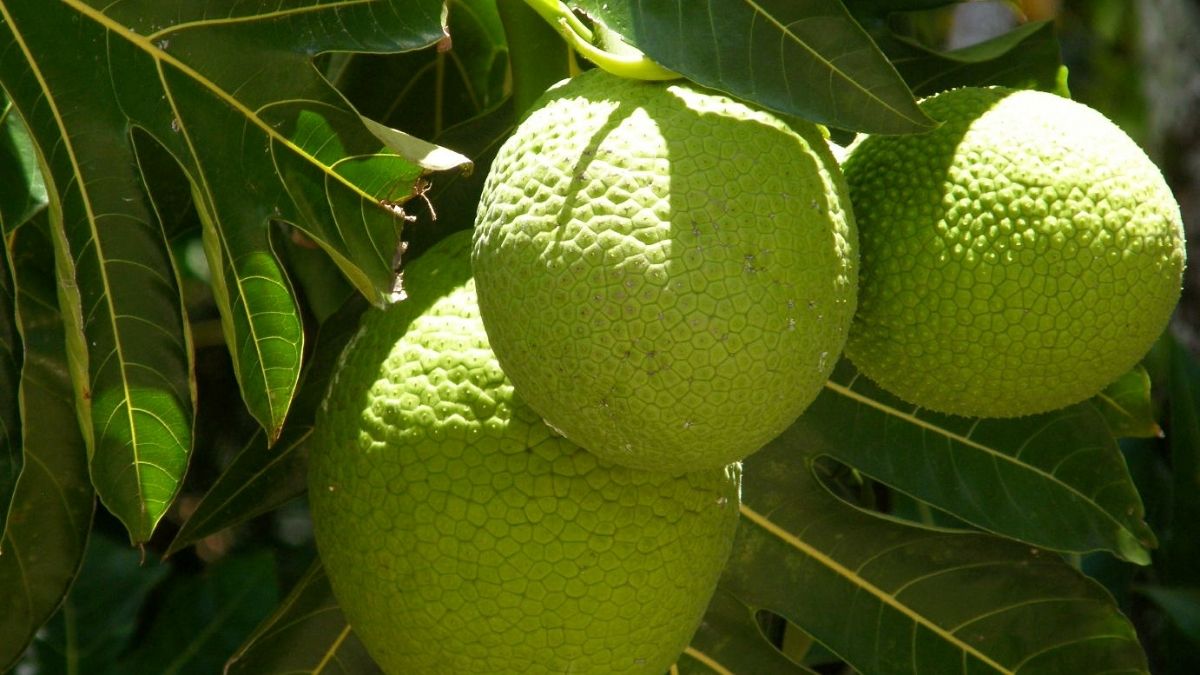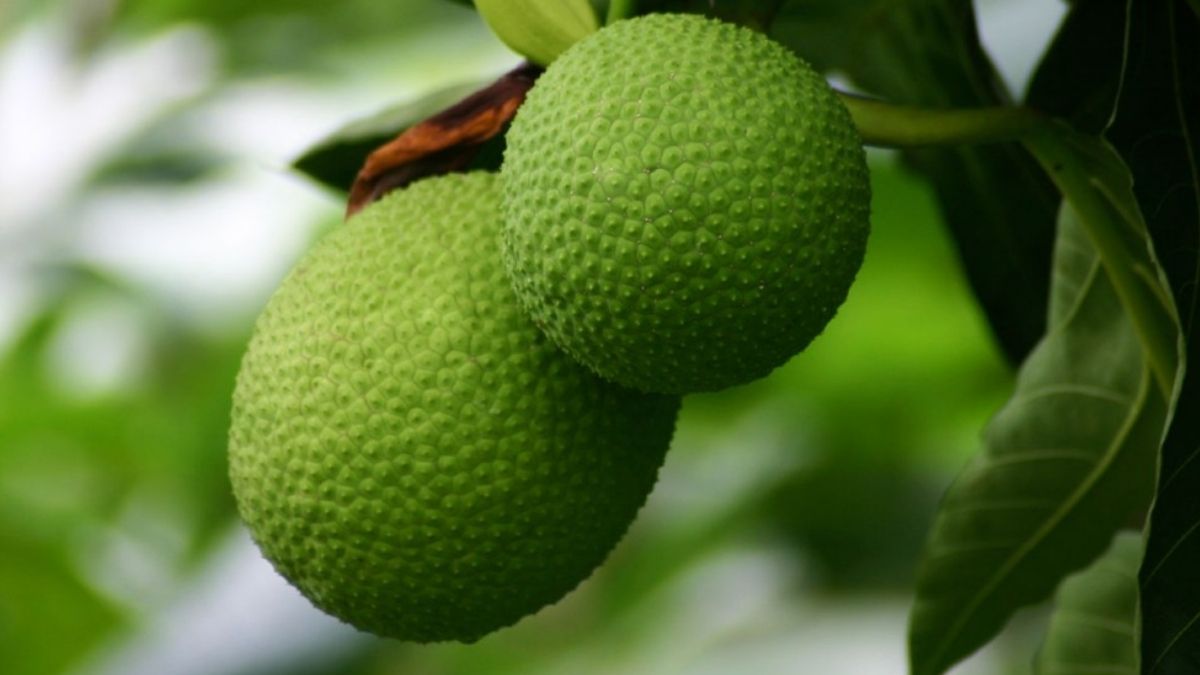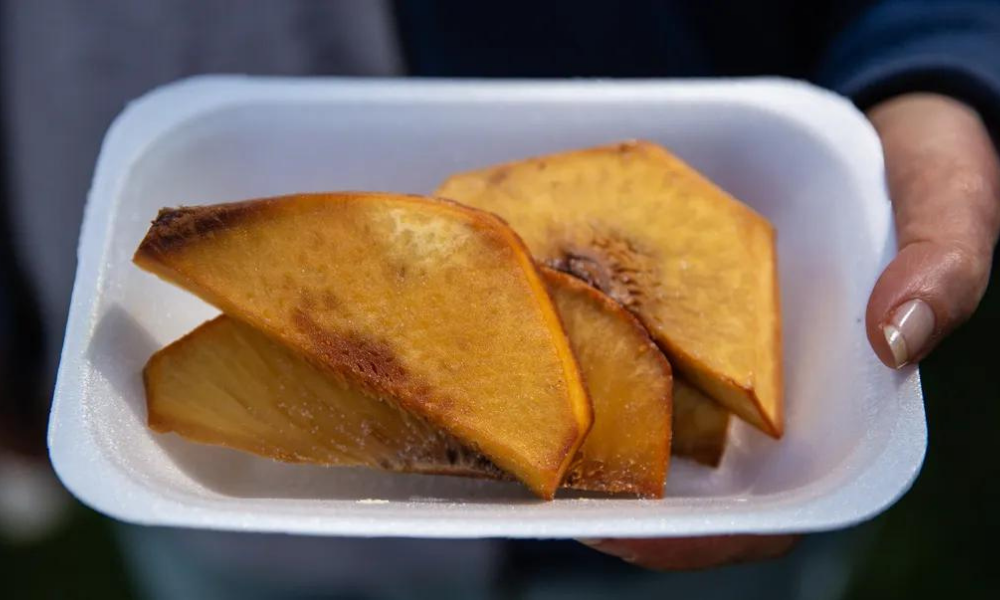Bread Fruit is a fruit. However, it is always cooked and eaten as a vegetable, despite its name. It can be picked and prepared at different stages of maturity, and it will be starchy and handled like a potato when unripe, with entirely green skin, and can be boiled or roasted.
Make sure the breadfruit is solid and has a greenish-yellow skin with only a slight brown cracking when choosing one. When cut, unripe fruits have vivid green flesh and leak a white fluid. The pulp has begun to spoil even before cutting the fruit if it feels squishy. Before removing the peel, cut the breadfruit into slices. It’s easy to cut through, even if it has a solid texture.
What is Breadfruit?
Breadfruit is a thorny, oval fruit native to the Pacific Islands and Southeast Asia. Breadfruit (Artocarpus altilis), a mulberry and jackfruit family (Moraceae), has been grown for about 3000 years. It has a potato flavor and a chewy texture, and it smells like freshly baked bread when baked or roasted, hence its name.
Its spiky bright green, football-shaped appearance may make it appear unappealing, yet it is tasty, high in nutrients, and aids in preventing chronic diseases. Breadfruit’s scientifically proven health advantages include its ability to control diabetes, lower blood pressure, improve digestion, and aid weight loss. It’s becoming increasingly popular worldwide as people experiment with new breadfruit recipes.
Can you Freeze Breadfruit?
One of the fascinating aspects of breadfruit is that it may be used at any stage of development and in various ways. It’s used in a variety of dishes. Cooked, baked, boiled, steamed, roasted, grilled, and even barbequed options. Isn’t it fantastic? When it is fully ripe, you can eat it uncooked.
You may quickly freeze this delicious fruit if you need it during the offseason. The best way to store baked breadfruit is to freeze it. Cook the item first, then cool it before placing it on the freezer rack. There will be some ice crystals created, and please place them in the freezer once it has frozen thoroughly.
Breadfruit that has been frozen should be defrosted in the refrigerator. After thawing, steam the breadfruit for a few minutes to bring back its fresh flavor.
How to Store Breadfruit?
No concerns if you got a lot of breadfruit at the market and didn’t want to eat them right away. You can easily keep and eat them anytime shortly. Here are some suggestions for adequately storing breadfruit.
Keep it somewhere cool and dark. Placing breadfruit in a cold, dark spot is one of the easiest and simplest ways to preserve it, and it will not spoil soon here. Alternatively, you can submerge them in cold water, and it will keep them for a more extended period here. In your own home, a refrigerator is an excellent place to be.
Drying
Breadfruit can be dried and stored, and it can be accomplished in various ways. It can be dried in the sun or an oven at roughly 50 degrees Celsius, and a dehydrator can also be used. Please place it in the plastic bag and adequately wrap it once it has dried.
Cooking it, mashing it, and making a paste are other approaches to dry it. Place the paste in an airtight jar or container after drying it in the sun or oven. Breadfruit paste isn’t used these days very much, but it’s still a tasty snack.
Fermentation
It is one of the most popular methods for storing breadfruit. Peeling, coring, and chopping up the fruit are all options. Then you have to bury it in the pit with breadfruit or other fruit leaves. Then you’ll need to cover it with more leaves, sacks, and stones. It is, nevertheless, a traditional method.
It’s now as easy as putting the peeled fruit in an airtight jar or container, and it’s a simple technique to keep your fruit fresh.
How Long does Breadfruit Last?
Breadfruit comes in two types, which is an intriguing tidbit to know. One is seedless, whereas the other has seeds. It can also be eaten as a vegetable, and its seeds are edible and can be used to produce a puree. If the breadfruit you bought is still fresh, it will easily survive 3 to 5 days. Make sure it’s stored somewhere cold and dry.
It’ll last for around three months if you’ve frozen it. Although freezing your product may alter its texture and flavor, it still preserves it and allows you to enjoy it at any time. Breadfruit that has been fermented will keep for around a year.
What are the Health Benefits of Breadfruits?
Let us look at the most critical proven benefits of this tropical fruit.
Helps in Diabetes Management
According to a study published in the journal Trends in Food Science & Technology in 2015, breadfruit has the potential to help manage type 2 diabetes due to its high nutrient content. The cooked fruit also has a low glycemic index, which may aid with hyperinsulinemia. However, more research is needed to confirm this feature of the starchy fruit.
Gluten-free
The fruit is an excellent gluten-free snack that can be converted into flour, according to a 2016 article published in the Foods journal. Breadfruit flour is inexpensive, making it more straightforward for the wallet. Dumplings, porridge, muffins, puddings, and buns can all be made using it. The flour is currently being researched for making nutrition bars and pasta.
Rich in Antioxidants
The fruit is substantial in antioxidants and flavonoids. The study suggests that the fruit’s pulp has antibacterial capabilities, inhibiting the growth of both gram-positive and gram-negative bacteria.
Aids Weight Loss
According to The National Tropical Botanical Garden in Hawaii, starchy fruit is a good substitute for rice, pasta, potato, or rice. It’s also a high-nutrition item that can keep you satisfied between meals and prevent you from nibbling.
Helps Manage Blood Pressure
Breadfruit can decrease blood pressure due to its high potassium content. In addition, an animal study indicated that aqueous extract of breadfruit leaves could be utilized as an antihypertensive treatment.
Boosts Digestion
The tropical fruit is abundant in soluble and insoluble dietary fiber, which aids in the maintenance of healthy gut flora.
Where and How Does Breadfruit Grow?
The breadfruit tree (Artocarpus altilis), so named because of its flavor and texture, is a member of the Moraceae family of mulberry and fig trees in New Guinea, the Maluku, and the Philippines, or later in Southeast Asia and the Pacific Islands. It thrives in tropical climates and bears fruit three to five years after planting.
The breadfruit tree has big pinnate leaves and reaches a height of 85 feet (26 meters). Latex, a white fluid produced by all three sections, is used for various applications, including boat caulking, construction materials, medicine, cloth, adhesive, insect repellent, animal feed, etc. The fruit is high in carbohydrate, dietary fiber, calcium, potassium, magnesium, riboflavin, thiamin, niacin, and iron at lower levels.
A single breadfruit tree can produce anywhere from 25 to 200 fruits in a single season. Rather than seeds, root cuttings or shoots are frequently used to propagate plants.
Does Breadfruit go Bad?
Breadfruit is a high-energy food, and it contains a high amount of fiber, which is beneficial to intestinal health. Its seeds are an excellent source of protein, and now that you’ve learned about all of the benefits of breadfruit, you might be wondering how to tell if it’s gone wrong.
Breadfruit that is rotting or spoilt is easy to spot. All you need to remember are a few points listed below.
- The pulp has gone wrong if the fruit feels soft or mushy before cutting. Softness is probably an indication of dehydration, and it should not be consumed.
- If you notice any mold, fungus, or bacterial growth, then better to throw them away if they are not suitable for your health.
- The appearance of black or brown spots on the breadfruit indicates that it has spoiled.
Conclusion
As its name implies, Breadfruit is a fruit that tastes similar to a loaf of baked bread or a potato. It has a soft, flat, sticky, and pulpy texture. It has a lovely flavor to it. Its origins are in New Guinea and the Indo Malay region. It is commonly used in Pacific islands, from which it spreads to the Caribbean and Africa’s coasts. It has the aroma of freshly baked bread. It’s high in carbohydrates, minerals, and vitamins A and C. A cup of raw breadfruit has 227 calories in it. Breadfruit (Artocarpus altilis), a mulberry (Moraceae) tree with big fruits that are a staple diet in the South Pacific and other tropical regions. Breadfruit is rarely eaten raw since it contains a lot of starch. Roasted, baked, boiled, fried, dried, and crushed into flour are all options.
The fibrous inner bark is used to make cloth, the wood is used to make boats and furniture, and the milky liquid is utilized to make glue and caulking material in the South Seas. Although the most robust taste comparison for breadfruit is freshly made bread, the starch-rich breadfruit can also taste like potatoes when cooked. However, riper types taste sweeter since the starch turns to sugar. The bloom effectively repels insects and mosquitoes. The latex from the tree is used as a sticky adhesive in the tropics. The tree’s bark is used to manufacture mosquito nets, clothing, and paper, among other things. The powdered leaves of the breadfruit tree were shown to help normalize blood cholesterol levels in an animal study published in the Journal of Physics.


